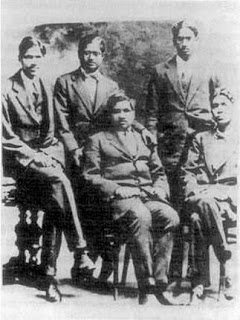Happy Birthday to Srinivasa Ramanujan, the great Indian mathematician
Today
is the birthday of Srinivasa Ramanujan, the great Indian mathematician who
studied number theory, mastered modular and partition functions, and designed
summation formulas. Ramanujan was born on December 22, 1887 in Erode, a city
along the banks of the Cauvery River in the southern state of Tamil Nadu. He
enrolled in a local high at the age of 10, but learned more about mathematics
from the college students who boarded in parents' home. According to Robert
Kanigel, Ramanujan's biographer and author of The Man Who Knew Infinity, the
young mathematician was deeply influenced by two borrowed books: S.L. Loney's
Plane Trigonometry and George Shoobridge Carr's Synopsis of Elementary Results
in Pure Mathematics. Carr's work, a list of 5000 mathematical formulas,
inspired Ramanujan to develop his own proofs for these theorems. By the age of
17, Ramanujan had calculated Euler's constant to 15 decimal places and proposed
a new class of numbers. Although his peers "stood in respectful awe of him",
said one contemporary, "we, including his teachers, rarely understood
him".
Like
Albert Einstein, Srinivasa Ramanujan struggled with school and even failed his
high school exams because of difficulties concentrating. In 1909, the 22-year
old college dropout moved from Erode to Madras and found work as a clerk in the
Accountant General's Office. Ramachandra Rao, an Indian mathematician who
helped Ramanujan obtain the clerkship, encouraged the young man to publish
papers and seek broader support for his work. In 1911, Ramanujan's 17-page
paper about Bernoulli numbers appeared in the Journal of the Indian
Mathematical Society. Two years later, the young mathematician wrote a 10-page
letter with over 120 statements of theorems on infinite series, improper
integrals, continued fractions, and number theory. The letter's recipient, a
Cambridge mathematician named G.H. Hardy, had ignored previous communications
from Ramanujan, but shared this latest letter with J.E. Littlewood, a
university colleague. According to Hardy, the English mathematicians concluded
that Ramanujan's results "must be true because, if they were not true, no
one would have the imagination to invent them."
With
Hardy's help, Ramanujan was named a research scholar at the University of
Madras, a position that doubled his clerk's salary and required only the
submission of quarterly reports about his work. In March 1914, Ramanujan
boarded a steamship for England and, upon his arrival at Cambridge University,
began a five-year collaboration with G.H. Hardy. Together, the scholars
identified the properties of highly composite numbers and studied the partition
function and its asymptotics. They also identified the Hardy-Ramanujan number
(1729), the smallest number expressible as the sum of two positive cubes in two
different ways. Individually, Ramanujan made major breakthroughs with gamma
functions, modular forms, divergent series, hypergeometric series, and mock
theta functions. He also developed closed-form expressions for non-simple,
continued fractions (Ramanujan's continued fractions) and defined a
mathematical concept known as the Ramanujan prime. "I still say to myself
when I am depressed, and find myself forced to listen to pompous and tiresome
people," Hardy later wrote, "'Well, I have done one thing you could
never have done, and that is to have collaborated with both Littlewood and
Ramanujan on something like equal terms.'"
Srinivasa
Ramanujan received an honorary bachelor's degree from Cambridge University in
1916, and was later appointed a Fellow of Trinity and a Fellow of the Royal
Society. Despite his professional accomplishments, Ramanujan suffered from poor
health and was eventually diagnosed with tuberculosis and amoebiasis, a
parasitic infection of the liver. A vegetarian, he also suffered from a severe
vitamin deficiency that may have been due to the shortage of fresh fruits and
vegetables in wartime England. Srinivasa Ramanujan died on April 26, 1920 at
the age of 33. Today, his home state of Tamil Nadu celebrates his birthday,
December 22, to memorialize both the man and his achievements.
G. H. Hardy liked to rank mathematicians on a
scale of 1 to 100, and he gave himself 25, Littlewood 30, David Hilbert 80, and
Ramanujan 100, which shows just how great Ramanujan was.





Blutick
ReplyDeleteMaths With Confidence
Online Maths Teaching
Thanks for sharing the informative post on Sh. Ramanujan Ji. Please keep sharing regular updates on your post Amit Sir!
ReplyDeleteIt's always useful to know about the Indian scholars who have raised the Indian Flag so high that it gives a sense of pride to ourselves. Sh. Ramanujan Ji has been a proven legend of our country. Thanks for sharing the useful information with us. All the best!
ReplyDelete